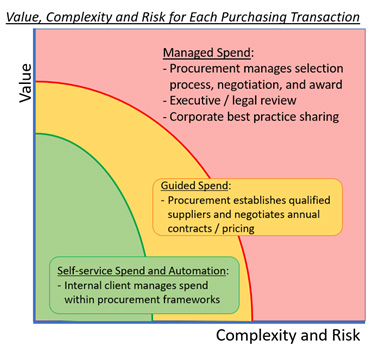Every Procurement organization struggles to balance competing goals and priorities with resources. For Indirect Procurement (the purchasing of materials and contracting of services that are not used directly in the product sold to the customer), the goals are twofold:
- to ensure that the company’s spend is managed in a way to maximize value, and
- to service the internal client well and quickly.
Increasingly, if your company is like mine, these goals need to be met with a very small Procurement team. Lax policies and loose procurement processes can lead to internal clients unwittingly (a) spending too much on some product or service for which there is already a great negotiated cost, or (b) exposing the company to unnecessary risks by agreeing to unfavorable terms and conditions without a proper review.  If the policies are too restrictive and the processes too cumbersome, more of the spend may be compliant and cost-effective, in the short-term, but the service may be slow and poor. Over time, the internal clients will then simply avoid the involvement of the over-taxed Purchasing team, making spend management and compliance much more difficult and, ultimately, less compliant.
If the policies are too restrictive and the processes too cumbersome, more of the spend may be compliant and cost-effective, in the short-term, but the service may be slow and poor. Over time, the internal clients will then simply avoid the involvement of the over-taxed Purchasing team, making spend management and compliance much more difficult and, ultimately, less compliant.
In working with my team to solve these seemingly competing issues, I realized that they are not in conflict at all, but mutually supportive. If you can service the clients quickly, they will happily comply with the policies and procedures, grateful that they were provided with a solution proactively and didn’t have to figure it out on their own. With a small team, the challenge is to target the limited Procurement resources on the right spend and get out of the way for everything else. So, we worked up a decision tool to guide us:
- Managed Spend: where we should spend our time through the whole procurement process,
- Self-Service Spend: where we should give the internal client a framework for servicing their own needs immediately, and
- Guided Spend: a hybrid for situations that fall between these extremes.
The key criteria for making the decisions are value compared with risk and complexity, which I am calling the Risk and Value analysis, or RaVA, for short. By value, I mean, the amount of spend, not in aggregate, but for each transaction. In most companies, most indirect purchasing transactions are small and of low value, with a concentrated number of high value transactions. By complexity or risk, I mean whether a contract is required, a clear statement of work is beneficial, or the service involves sharing of sensitive information or intellectual property. I am depicting how to manage the spend using these criteria in a graph with areas defined by non-linear boundaries, where the greater the spend or risk/complexity, the more likely the approach is Managed Spend, with the Purchasing team’s full engagement from beginning to end. The graph shows that the risk/complexity has greater weight in the decision making than the value, in order that the company is better protected, even when a transaction is of lesser value. In this article, I will deal only with self-service models, as it is a very under-utilized method to provide the most value and internal client satisfaction, the most quickly.
For small value transaction, and especially routine recurring transaction, you can offer the internal client self-service options, such as access to a preferred supplier’s web portal. With a properly defined program, the internal client would be provided with a departmental log-in, that guided them to commonly used items for which the Purchasing team has already negotiated deep discounts based on leveraged volumes from approved suppliers. By pre-selecting common items in a company-specific “catalog”, the Purchasing team can prevent clients from purchasing almost identical items in small volumes from dozens of suppliers, thereby decreasing the probability of deeper discounts. The log-in can also ensure the costs are billed with encoding that guides your Accounting department to allocate the costs to the right divisions and departments. Office supply distributors such as Staples and Office Depot, desktop computing distributors such as CDW and Insight, and many other types of vendors offer these programs. A similar and complementary program, especially designed for production and warehousing facilities where internal clients may not have access to computers, is a vending machine program, where the client extracts the tools, PPE, or MRO supplies they need by either typing in a code or using a card linked to their department. Industrial distributors like Grainger and MSC offer such vending machine programs to customers.
While these Self-service Spend programs support well the routine and frequently repeated transactions, many types of low-value and low-risk transactions are non-recurring, and my preferred solution for these transactions is to provide the internal clients with a procurement card, or P-card, where the client can pay for many things, from any prospective supplier. Moreover, the Purchasing team can define types of purchases allowable based on vendor/ industry codes, as well as transactional or periodic limits to the spend. And, again, the program can submit the payment information in a way to ensure proper departmental accounting of the expenses.
All these programs eliminate the transactional cost of a purchase, including requisition approvals, purchase order creation, and one-off invoicing, thereby significantly reducing the costs of each transaction. In addition, while they may remove the Purchasing team from the transactional activity, they do not prevent supervising the spend and adding value through supplier management and volume negotiations. Each program would be supported with reporting that summarizes spend activity, pointing to areas of negotiating leverage,orthat calls out exceptional situations, where spending may be excessive or unnecessary. The Procurement team should define a cadence of analyzing the dataforspend management, negotiation opportunities and compliance. In addition, the team should be gathering feedback from internal clients regularly to ensure the suppliers’ service levels are proactively managed through surveys and providing performance feedback to the supplier through QBRs.
While I am using the RaVa analysis to guide the use of resources for Procurement here, it can be used to service clients (internal or external), regardless of your function (IT, Procurement, or something else). So, ask yourself where you can provide a higher level of service by developing programs or processes that focus your team’s energy on high impact areas, and empower your clients to solve their own their low-value and low-risk issues. And then, just get out of the way.













